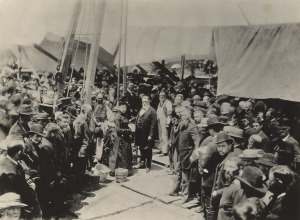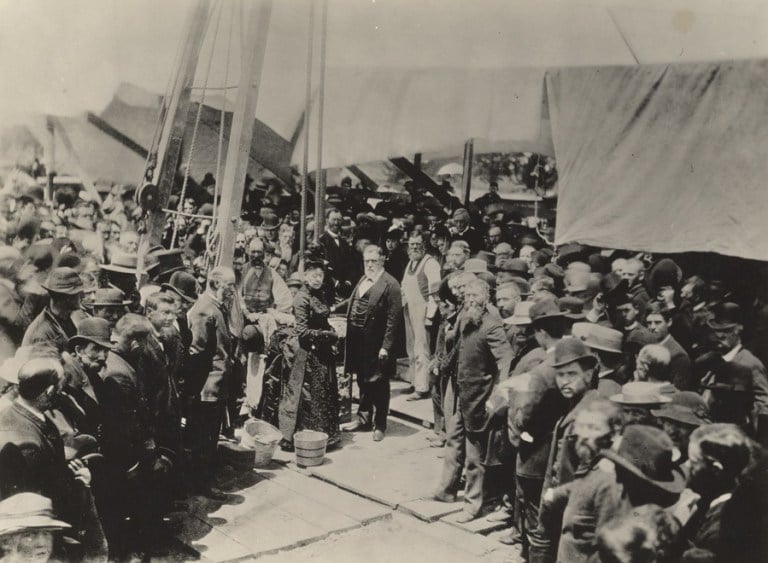
Leland Stanford, though himself a multimillionaire and a “robber baron,” was not the die-hard capitalist we may presume him to be, according to the research of alumnus Lee Altenberg Ph.D. ’84 PD ’85.
Rather, Altenberg found that Stanford championed the idea of a world where business was controlled not by monopolies but by laborers, founding a university that he hoped would foster this vision — a hope the Stanford University of today seems to have forgotten, according to Altenberg.
“This piece of Stanford history has fallen through the cracks of the institution’s collective memory,” said Altenberg, who published his findings in a 1990 issue of the Stanford Historical Society’s journal “Sandstone & Tile.”
In letters and speeches, Stanford reiterated the idea that “when money is controlled by a few it gives that few an undue power and control over labor and the resources of the country.”
In the University’s Grant of Endowment itself, Stanford declared that it would be the duty of the Trustees “to have taught in the University…the right and advantages of association and co-operation.”
Altenberg, an evolutionary theorist, became interested in the issue while doing postdoctoral work at Stanford in the 1980s.
He’d heard rumors that Leland Stanford was interested in cooperative living. After doing some research, he found a plethora of archival evidence showing Stanford’s serious commitment to the values of cooperation.
The result would surprise anyone who thinks of Leland Stanford solely as a titan of monopolized industry.
“He was deeper than what that success conferred upon him,” Altenberg said.
As a United States senator, Stanford introduced two bills — never passed — which were decried as “fully impregnated with socialistic ideas.” His politics struck such a chord with the Populist Party, which advocated the interests of farmers and laborers, that there were calls within the movement to nominate him for the 1892 presidency (Stanford, elected as a Republican, declined.)
Though he proposed some of the most radical economic policies in the Senate, Stanford could not have been called a socialist, according to Alternberg.
Instead, he took a “third way,” advocating free enterprise in the form of direct worker ownership.
The magnate of the Central Pacific Railroad emerged as a representative of the interests of the common man.
“In the unrest of the masses I augur great good,” Stanford said. “It is by their realizing that their condition of life is not what it ought to be that vast improvements may be accomplished.”
Stanford emphasized many times that he wished Stanford University to reflect his principles.
One of the main objectives of the university was to be “the independence of capital and the self-employment of non-capitalist classes, by such system of instruction as will tend to the establishment of cooperative effort in the industrial systems of the future,” wrote Stanford.
And he welcomed non-capitalist classes most particularly to the University:
“The few very rich can get their education anywhere,” Stanford said. “They will be welcome to this institution if they come, but the object is more particularly to reach the multitude — those people who have to consider the expenditure of every dollar.”
As to why this important aspect of Stanford’s dream for his university is not common knowledge, Altenberg can only speculate.
During Stanford’s 1985-91 Centennial celebration, Altenberg and then-Stanford professor Henry Levin hoped to bring a prominent historian of the Populists to campus to talk about Stanford’s ideas about cooperatives.
“We found [Leland Stanford] really fascinating,” Levin said.
“I mean, there’s this really rich guy who had a lot of wealth, who had accumulated it in some questionable ways, and all of a sudden he’s talking about democratic organizations, he’s talking about workers who participate in the decision-making,” he added.
The two thought the Centennial would be a good opportunity to remember Stanford’s “forgotten vision.” The planning committee, however, rejected their proposal.
Altenberg suggests that this may be because this aspect of Stanford’s history doesn’t contribute to the current ‘branding’ of the institution, which stays far away from the idea of critiquing the current industrial system and envisioning alternatives to it.
Altenberg also proposes that part of the reason Stanford’s ideals didn’t stick with the university over the years is that Leland Stanford died a mere two years after the University opened, and with him died the impetus behind his plans to have “association and co-operation” taught there to all students.
After the election of President William McKinley in 1896, widespread support for the Populist movement, aligned with Leland’s aims, died out, and neither Jane Stanford nor the staff of the University carried on this part of his wishes.
Regardless, Altenberg believes that there is still an obligation to share and discuss Stanford’s ideas rather than forget them over time.
“This particular story of Stanford’s history is important with the idea of preserving the diversity of ideas about things, and approaches, and ways of doing,” Altenberg said. “[It’s] a part of showing us that there can be a lot of diversity in thinking that gets lost, and we need to take active steps to cultivate our reserves of concepts.”
Contact Abigail Schott-Rosenfield at aschott ‘at’ stanford.edu.
